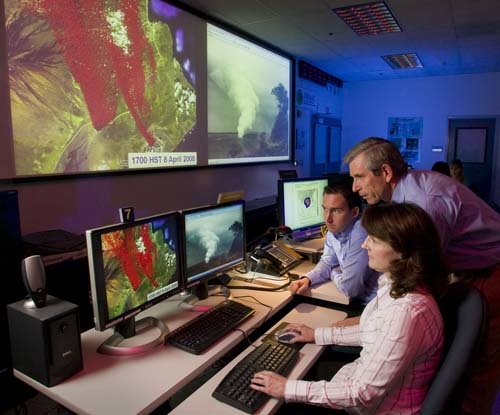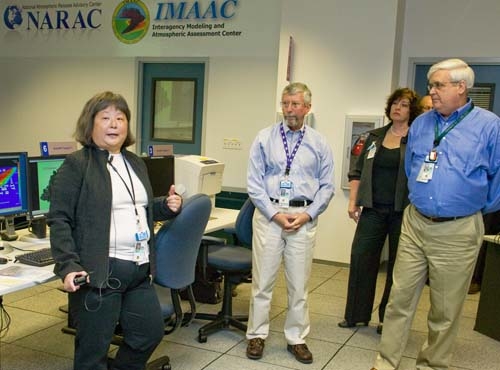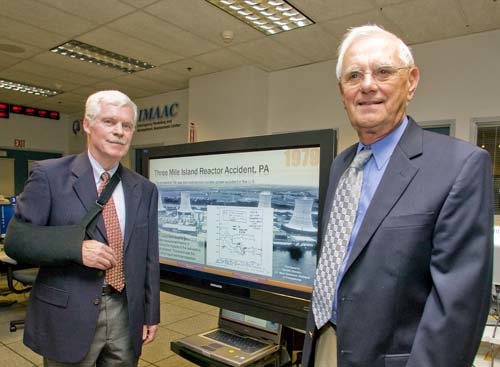Marking 30 years of atmospheric monitoring
The first call came in 1979 when an accident occurred at the Three Mile Island nuclear power plant near Harrisburg, Penn. Employees at Livermore's National Atmospheric Release Advisory Center (NARAC) worked around the clock for the next two weeks to predict the levels and areas of radioactive contamination.
Three decades later, NARAC is doing that and much more. NARAC observed its 30th anniversary earlier this week with a special celebration that included current and former NARAC employees.
Lab Director George Miller, Global Security Principal Associate Director John Doesburg and Debbie Wilber, director of DOE/NNSA's Office of Emergency Response, all attended the anniversary event.
"I remember the early days of these activities," Miller said. "The atmospheric science program is a prime example of what we do well. This is one of the Lab's premier facilities. It takes a lot of dedication to be a 24/7 center."
The center provides critical information on the potential impacts of hazardous airborne releases, as part of an integrated national preparedness and response strategy. NARAC responds to toxic industrial chemical spills, fires, biological and chemical agent releases, radiological dispersal device and improvised nuclear device scenarios, NASA spacecraft launches, and nuclear power plant accidents. NARAC predictions provide information on affected areas and populations, estimated casualties, and health effect and protective action guideline levels to assist decision makers and responders.
NARAC is the DOE modeling center for radiological/nuclear incident response. Since 2004, NARAC also has been the primary provider of capabilities for the DHS-led Interagency Modeling and Atmospheric Assessment Center (IMAAC), which responds to all hazards and coordinates federal plume modeling for major events.
"Over the years since its inception, NARAC has developed a suite of modeling tools and databases that has cut response time down from hours to minutes," said Gayle Sugiyama, NARAC director. "But our most important asset is the multi-disciplinary staff that work here and their ability to work collaboratively with local, state, and federal emergency responders, decision makers, operations centers, and deployed field teams."
The concept for the center originated in 1973 as a DOE feasibility study. At that time, LLNL designed and demonstrated how an integrated atmospheric modeling system could provide reliable and timely dose-assessment advisories to emergency managers at DOE nuclear facilities and U.S. nuclear power plants in the event of accidental emissions to the atmosphere.
"NARAC is a key component of NNSA's emergency response teams, and, along with other NNSA assets, provides the nation with critical expertise to help resolve radiological emergencies," said NNSA Associate Administrator for Emergency Operations Joseph Krol. "On behalf of NNSA, I congratulate everyone at NARAC for their invaluable contributions to our nuclear security mission over the last three decades."
In 1978, when the Chinese conducted atmospheric nuclear-weapons tests, Lab scientists estimated the path of nuclear debris from those tests in the remote Lop Nur region. That same year, Lab responders followed the steady decline of the orbit of the Soviet satellite Cosmos 954 powered by a nuclear reactor and calculated possible contamination footprints in case of re-entry. On January 16, 1978, the satellite crashed in a remote area of northern Canada. Over the next several weeks, U.S. aerial and ground survey crews assisted the Canadian clean-up effort, also known as Operation Morning Light.
But it really wasn't until March 28, 1979, when the most serious nuclear power accident in the United States occurred at the Three Mile Island Nuclear Generating Station that the center became operational. LLNL used its newly developed modeling system to generate maps to guide DOE and state measurement teams in determining the impacts from the radiological material released. This event was NARAC's first major response.
"We had hand-drawn plots," said Marv Dickerson, who helped lead LLNL's support during the incident. "When we got the news about Three Mile Island, we didn't know how serious it was until about a day later."
The original NARAC computer system was the first operational system using advanced 3D models for emergency planning and response. The system was based on mini-computers at LLNL and seven DOE remote sites and LLNL supercomputers for computational modeling.
"The computers we were using were state of the art at the time, but there is more in a laptop today in terms of speed and capability than what we had," said Tom Sullivan, a former NARAC scientist.
The 1982 second-generation NARAC system added capabilities to allow model simulations to be easily run anywhere in the country. The system used desktop computers at up to 70 remote sites and a dedicated NARAC central computer system at LLNL.
In 1986, NARAC was tested again. In late April, a partial core meltdown at the Chernobyl nuclear power plant in the Soviet Union resulted in an explosion that blew the 100-ton lid off the reactor core. Millions of curies of iodine and cesium were released. Over the next 16 days, NARAC estimated the activity released, modeled the transport and deposition of the material involved, and calculated the dose to people in Europe and around the globe.
After the Chernobyl accident, LLNL developed global geographical databases (terrain elevation, maps) to more quickly respond to accidents anywhere in the world. More recently, LLNL has incorporated an Oak Ridge National Laboratory (ORNL) database to provide time-varying population density. New databases for rural and urban land-use characteristics were added to incorporate their effects on wind and turbulence.
In the 1990s, NARAC researchers fine-tuned their capabilities in urban transport and fate, dense-gas dispersion, as well as toxic chemical and biological agent modeling. More recently, LLNL scientist have developed indoor-outdoor air exchange models (with LBNL and ANL), probabilistic event reconstruction tools, and enhanced explosive dispersal and fallout models. In collaboration with DOE and other agencies, LLNL is also developing electronic data exchange software to rapidly process and analyze measurements data for updating plume model predictions.
In 2000, the third-generation Unix-based NARAC central computer system came on line using modern computer technology and next-generation atmospheric models. The system included a greatly expanded ability to use global and high-resolution weather forecast models and higher-resolution weather observation networks.
"We wouldn't be here today if it weren't for the level of excellence for the past 30 years," Doesburg said at the anniversary event. "This is the first celebration of what we'll have in 60 or 90 years."








